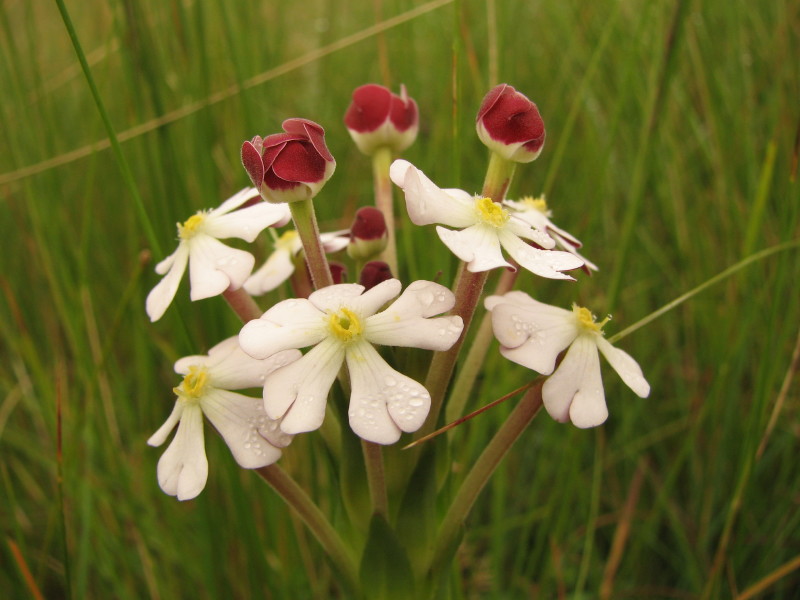Several factors contribute to the Maputaland-Pondoland-Albany Hotspot’s biodiversity, including the rugged topography, underlying geology and varying climate.
Plants
Maputaland-Pondoland-Albany is an important center of plant endemism, and the second richest floristic region in Africa after the Cape Floristic Region. In total, about 8,100 species of plants from 243 families occur within this hotspot, and nearly a quarter of these—at least 1,900 species—are found nowhere else. This includes 39 endemic genera (among 1,500 genera in total), and one endemic family: the Rhynchocalycaceae, which is represented by a single species, Rhynchocalyx lawsonioides, found only in Pondoland in southern KwaZulu-Natal and the eastern Transkei area of the Eastern Cape.
The bird-of-paradise flower (Strelitzia reginae) is endemic to the hotspot and can grow up to two meters in its natural habitat in the Eastern Cape coastal bush. It is a popular horticultural subject in many parts of the world and has even been adopted as the civic emblem of Los Angeles. The once plentiful Sandersonia aurantiaca, a monotypic endemic genus whose beautiful orange-yellow flowers has led to the species common name of Christmas bells, is becoming increasingly rare.
Birds
Birds are the most diverse group of vertebrates in the hotspot. Fourteen of the 631 species are endemic. Twenty-five globally threatened southern African bird species occur within Maputaland-Pondoland-Albany. Four of these are endemic to the region.
Mammals
Of the nearly 200 mammal species found in the hotspot, four are endemic: the red bush squirrel (Paraxerus palliates), the four-toed elephant shrew (Petrodromus tetradactylus), Marley's golden mole (Amblysomus marleyi) and the Endangered giant golden mole (Chrysospalax trevelyani).
One of the most notable mammal species in the hotspot is the southern subspecies of the white rhinoceros (Ceratotherium simum simum). Once common and widely distributed throughout southern and East Africa, the species was greatly reduced due to hunting for its prized horn. Once near extinction, with only a few dozen individuals remaining in KwaZulu-Natal's Hluhluwe-Umfolozi Park, the subspecies was saved in one of the greatest success stories in conservation. Today, there are more than 12,000 individuals, many of which have been relocated to parks and reserves outside KwaZulu-Natal and beyond the borders of South Africa.
Reptiles
More than 200 reptile species are found in the hotspot, roughly 30 of which are endemic. These include the Critically Endangered Natal hinged tortoise (Kinixys natalensis) and the Critically Endangered Albany adder (Bitis albanica).
Amphibians
All 72 of the hotspot's amphibian species are frogs, eleven of which are endemic. Notable species include the Endangered Pickersgill's reed frog (Hyperolius pickersgilli) and the recently described soprano or whistling frog (Breviceps sopranos), which utters a long, high-pitched whistle.
Freshwater fishes
There are no less than three Critically Endangered and 12 Endangered freshwater fish species, including a number of Barbus and Pseudobarbus species, as well as the East Cape rocky (Sandelia bainsii). The Critically Endangered estuarine pipefish (Syngnathus watermeyeri) is now restricted to the small East Kleinemonde estuary in the Albany region, caused by loss of water flow due to the construction of numerous small farm dams on its catchments and loss of eelgrass habitat in estuaries.
Invertebrates
The Maputaland-Pondoland-Albany Hotspot has an exceptionally rich and diverse invertebrate fauna. There are a number of butterfly and moth species found here, including the spectacular Charaxes pondoensis, which is confined to a small area of coastal forest near Port St. Johns.
The hotspot is also home to many species of the phylum Onychophora (velvet worms), a fascinating group of ancient, caterpillar-like animals that are the most primitive group to walk with the body raised up on legs.
Read more about the hotspot's species in chapter two of our ecosystem profile (PDF - 2.8 MB).





